Trading ASCII: Traditional Roguelike Early Access Sales Results

Cogmind recently ended its second full year of sales in early access prior to release on Steam, so I want, as last year , to share data and beautiful graphs.
This is an interesting milestone because it more or less coincides with the completion of the initial content of Cogmind, presented in a beta release last month. This means that it took two years to go from Alpha 1 to Beta 1. And it is still surprising that the support provided is enough for further full-time development - the income from Cogmind for its entire life span exceeded the mark of 100 thousand dollars in April . Therefore, I am grateful to everyone who allowed me to reach this stage!
')

@ celebrate beta
A more general result of the development of late alpha can be explored in my 2016 report , so in this article I will mainly look at revenues and pricing. In the first year of sales, the data was good simply because it seems that for the first time in this genre someone provided so much open data. The second year is much more interesting because of changes in the price category and the cost of the game.
Income
Immediately to the point: for the second year Cogmind earned 40 325 dollars. If you look only at the numbers, this is only two-thirds of what she earned in the year before, but it is important to note that $ 25,000 from the first year’s earnings were received in the first month of alpha. This was the result of increased interest due to two years of open pre-alpha development. Considering this, technically, the second year in terms of income was slightly better : an increase of 8%, from 37 to 40 thousand.
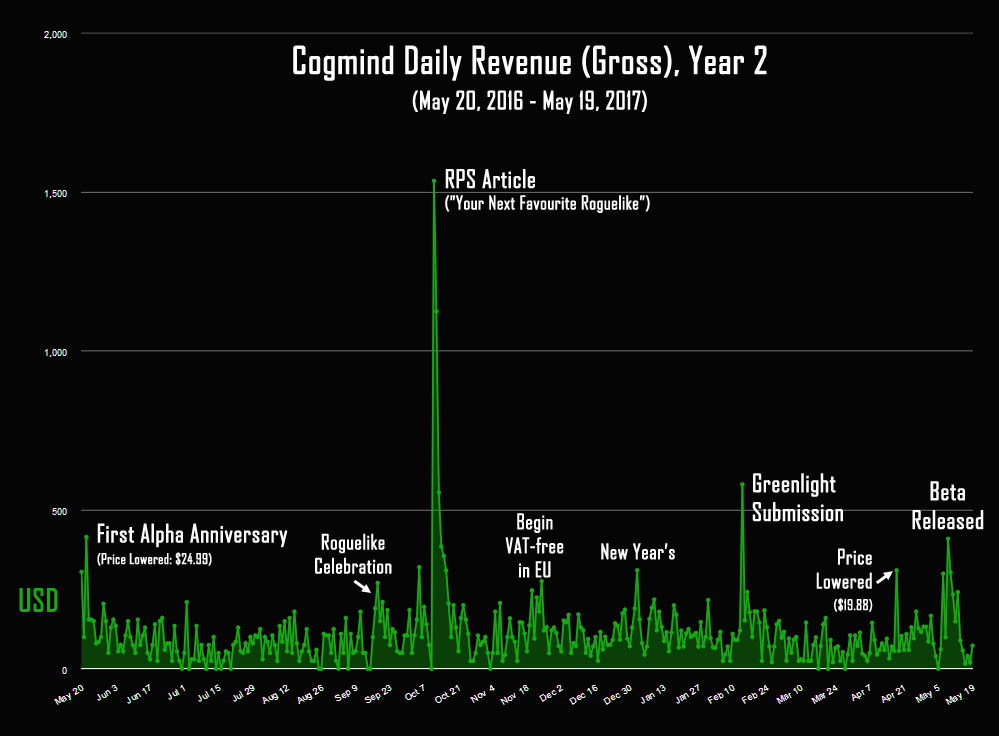
Cogmind’s daily gross income for the second year with comments (the first year’s schedule is here ) .
The second year began with a small price reduction: from $ 30 to $ 24.99 (a new low price option was added without any advantages, while maintaining the old one). Naturally, this led to a short-term jump in sales, which eventually fell asleep. The growth in the number of players returned to normal after the game was acquired by all the buyers who were waiting for this discount. At this stage, the price change did not seem to have a lasting effect, but we turn to the data about it later.
The following noticeable upswing coincides with Roguelike Celebration , a terrific event where I gave a talk , and after which news of Cogmind began to spread. The effect of this event lasted a good two weeks.
Then came the obvious peak. Rock, Paper, Shotgun (RPS) followed Cogmind with pre-alpha, and I did not expect them to publish anything else after alpha. Therefore, the suddenly appeared article was a pleasant surprise for me.
From mid-November, buyers from the European Union were finally able to get Cogmind without VAT (VAT) , which, in essence, meant losses for me, despite the fact that in the gaming industry, VAT is usually included in the price. I realized that I still lose money in the development process, but it took me a year and a half to mature to give up 20% of the revenues in this region. After these changes, I received $ 5,085 from the EU countries from November 15 to June 6, and $ 1,271 was spent on additional taxes (lower estimate). I could get all this money for development if Cogmind were released before 2015, when the EU introduced VAT on online purchases!
On New Years, I made a GIF with fireworks from ASCII (the first version of what is shown at the very beginning of the post) and this attracted attention , which almost always leads to an increase in sales. I did not make the animation for this, it was just a fun side-project, checking the engine's capabilities, but it was nice that such an additional effect arose.
In February, Valve tentatively announced the completion of the Greenlight program. Since I was not sure if 1) I would like to replace it, 2) knew that a small campaign in Greenlight would attract some attention by itself, and 3) I still had all the necessary resources on my website, I decided put Cogmind to vote . Only two days elapsed between making this decision and clicking on “Publish”. The game was approved almost immediately, but the goal was not this - notice a small peak on the chart. It's nice to get some free promotion on Steam: people who were impatient could already buy the game on my site! Cogmind's withdrawal in Greenlight instantly brought me about $ 750.
In April, I again lowered the price to the current and final level. At this price, I always planned to sell Cogmind after the completion of the main game. In this sense, the price change occurred a little earlier than planned, because the beta would be released not earlier than the beginning of the next month, and sales began to decline in the last six weeks. But revenues should not have dropped too low, because they were required for me to output a more complete game on Steam. (Other reasons: besides, it was a good excuse / opportunity to advertise the game a little, not overlapping the beta release. Besides, I needed a bigger buffer between the price change and the close Cogmind debut on Steam.) Actually, I secretly lowered the price a week before the announcement of the discount, just to see how it affects the random visitors. The impression was good, despite the fact that one week was too little, besides there were many other factors, so there is no possibility to draw any conclusions. (I’ll give you more details below to shed light on conversion levels.)
The most recent small burst was the release of beta , a rather large milestone. She allowed me to announce that Cogmind, in essence, is ready for many indicators. Many people have been waiting for this, and last month I lowered the price. All of these factors caused a decent income in May.
Another factor that I found when studying daily income charts was “zero days” (they are not so easy to notice). Every day during which there were no sales is a “zero day”, and too many of them, especially in a row, can demotivate. On the other hand, constant series of days with at least a small amount of sales are quite strongly motivating, even if it is only one or two sales. I always keep track of the number of sales (it’s easy to keep track of them, because I get letters about each of the sales: I don’t read them, but watch how the counter value increases), and when I start seeing zeros, I realize that I don’t talk enough about development, for example, in social networks. With a long series of sales days, I always work harder, so the transition to posting updates is a good, self-sustaining, long-term cycle - especially when I wake up in the morning and see how many people read me overnight! Over the past two years, it has already become my morning ritual ...
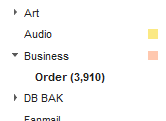
The most important is the order counter
During the second year, I was more eager to have something to show at least once a week, and I believe that this affected a relatively small number of zero days: in the first year there were 9.8% (36) zero days, and in the second - 4.9% (18). In fact, from a technical point of view, the result is even better: notice that a third of the zero days of the second year happened almost simultaneously, approximately in the summer of 2016, during my monthly vacation . No work - no pay.

Cogmind zero income days in the second year.
If you look at the monthly income, during the past year there has been a clear positive trend. (Thanks to the release of beta, revenues for May exceeded 3,000, but this is not shown on the chart, because technically this data was transferred to the third year.)

Cogmind's monthly gross income with comments.
I noted some of the most important effects described earlier, but I could not find a reasonable explanation for March. The graph shows the first year for comparison, but I have not commented on these months - all the information is in the first year data .
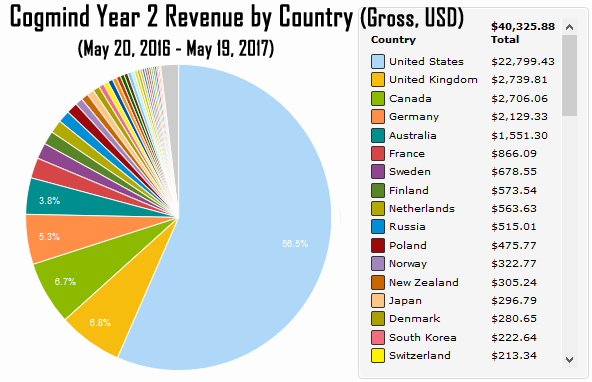
Monthly income from Cogmind for the second year by country.
There are not many surprises in the data on income in different countries. Compared to the first-year earnings schedule, the only noticeable difference was that Germany overtook Australia, which is quite interesting: it was assumed that the exclusively English-language game Cogmind would be mainly sold in English-speaking countries. Of course, there are many English-speaking users in Germany, and the population is three times larger than in Australia, and (perhaps the secret is this) several German lestplayers played Cogmind last year. (Plus the above-mentioned change with VAT in November!)
This schedule would be much more interesting in the presence of localization, but at least it gives an idea of what can only be achieved by an English-language game with a large amount of text in the international market. Localization is a great idea for any game whose authors can afford it, but, unfortunately, it is simply impossible to implement it in Cogmind.
Pricing
But we still have some interesting data for the analysis of the second year of Cogmind sales - now we have several categories and prices!
At the beginning of the year I wrote a lot about the first price change for Cogmind in 2016, including considering some common and not quite familiar variables that influenced pricing decisions. Here I will add to my reasoning the final results of such changes and the most recent third phase.
Let me remind you that Cogmind’s base price was $ 30 for the first 12 months, $ 24.99 for the next 11 months, and then $ 19.88 for the last month of the second year (and until now). Above, in the context of daily income, I have already talked about some of the instantaneous effects of such price changes, but there are other details in the detailed picture. One of them: I finally had enough data to investigate the conversion rate of Cogmind.

Cogmind conversion rate for all life (May 2015 ~ May 2017), based on data about visitors buy.html.
I would not attach much importance to this graphic, because there are many factors influencing how much, that this data is not as significant as it seems. But the schedule is interesting, so I’ll tell you about it anyway.
First, notice that this is exactly the purchase page ! Unlike many other indie developers, I did not post a link to the purchase page directly on the Cogmind main page. In fact, I did not even place it at the top or in the center of the purchase page itself! I prefer 1) not pushing on impulse purchases and 2) managing the expectations of the potential user. Therefore, I intentionally encourage visitors to wander around the site to find a link to buy the game. Yes, it’s counterproductive in terms of marketing, but I don’t care. I make a good game and create a healthy community, rather than trying to cut money from random people from the Internet.
Therefore, these source data definitely shift the conversion rate up, because everyone on this page is already more interested in buying than the average buyer. (Note that according to industry standard data, these figures are high.) For comparison, I did the same with /cogmind/index.html .

The conversion rate for the entire lifetime of Cogmind (May 2015 ~ May 2017) based on data about visitors index.html.
Part of the problem with the initial conversion statistics from the main page is that they are filled with referral spam, which cannot always be separated from real visits (visitors, like omnipresent referral spam, can leave without visiting other pages). That is why the purchase page gives better metrics, because it does not receive referral spam. We only need to take into account all the additional factors affecting the statistics of buy.html.
By the way, about these factors: information about Cogmind mainly spread through roguelike-related channels, so new visitors entering the purchase page should already be roguelike lovers, which means that the probability of a purchase increases.
In addition, I prefer to rely on data from the purchase page because many people who have been following development for a long time (sometimes for years) once make a decision to buy at a convenient time for them. The reason may be a price reduction, a good time, or another combination of personality factors. I believe that there is a fairly steady stream of people falling into this category. They just go to the purchase page and ... buy. Often this happens after receiving information about the game on one of the channels that I use, such as Twitter , r / Cogmind , forums , development blog , TIGS , Bay 12 , Facebook , etc ...
Regarding the trend of increasing conversion rate: it is logical, if we associate it with the fall in prices during this period. I think this trend is much less significant when breaking down the average number of daily visitors. I wonder where these numbers come from. For example, in the first year of release, the game Cogmind was demonstrated on many large sites, so visitors from these sites will most likely not be the target audience. The highest average was 71.8 visitors per day. In the second period, when there was less advertising on the general channels, the number of visits dropped significantly: to 47.5 visitors per day. And in the last period, with the lowest price, only 43.5 visitors per day were registered, but the conversion rate was the highest.
Of course, knowledge of this information does not disprove the fact that the Cogmind website and my frequent and my frequent moments of communication with the community are quite effective in selling the game to interested users. On the other hand, they supported the likelihood of increased conversion rates, with each subsequent period Cogmind was getting closer and closer to completion, and the history of permanent releases became longer. This helped to convince everyone who found the game that this is an important and promising project.
One of the most interesting indicators for me was the percentage estimate of those who would prefer to pay more than the minimum price, and watching how this percentage changes with price changes.
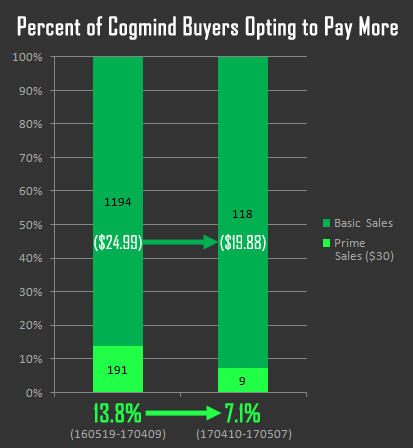
The percentage of Cogmind buyers who prefer to pay more. (These data consider the two lowest price options for the selected period, because the higher options are more difficult and target group purchases. The Prime tier price option and each corresponding option are more convenient to compare without advantage.)
After the first year, when the lowest price was $ 30 (“Prime Tier”), I added a new Alpha Tier for $ 24.99, which did not give any advantages. Over the next 11 months, buyers could choose whether they just wanted to buy the game or invest a little more so that their name appeared in the credits. Surprisingly, 13.8% of individual buyers still chose Prime tier!
Part of the reason for this was the relatively small percentage difference in prices. Only 20% more for additional benefits and to help your favorite project? Why not? Compare with the figures when the price dropped to $ 19.88, that is, Prime had to pay 50% (!) More: the percentage of buyers choosing this option was almost halved. Many of the long-time fans who want to pay more to support the project have already done so anyway. (It is worth noting, however, that the data for the last period were collected for only about a month, because I refused to issue Prime tier when I released the beta. I don’t think the difference would be greater if I continued selling this option. I got rid of it mainly because that the development of a transition to a new phase, and the preservation of the purchase option for "assistants in the early stages" seemed no longer suitable.
As a result, I am very pleased with my management of purchase options and prices, because otherwise Cogmind would not have gotten so far in the development process before it was published on Steam! If I had reduced the price to 19.88 dollars earlier, it would be a bad move (judging by what I see): in the long run, there is no significant increase in the total number of buyers. For many people, everything in the range of 19-30 dollars falls into the category of “too expensive.” In addition, the game is not sold on Steam, where the convenience of buying could stimulate someone to exceed their price limit, or where you could enter a discount as an additional incentive. (I'm still not seeking to reach more consumers to the detriment of income per player and still use the good old social networks, but this is why I chose April-May, that is, the approximate transition time to Steam.)
However, I will not argue that while maintaining the price of 24.99, I would continue to receive proportionally more income. Probably, if not for the price reduction, conversion rates would have fallen. With each price drop during these two years, I saw sales start to go down, and I would continue this trend if I hadn’t done anything. And even though this could not have happened, I also knew that there was already a hidden interest in lowering the price, so it was time to lower the threshold a bit in order to attract more new players.
Investments
So where did the money go? Well, I'm a lone developer with relatively low resource costs, so most of it, naturally, was spent on my modest “salary” for building and selling Cogmind.
As always, I laid out the details of the development time. They showed that, compared to 3,065 hours of pre-alpha development and 2,177 hours of the first year of alpha, the second year continued with a stable 2,192 hours of work. These numbers are not very pleasant, because they show that for such an income is a large amount of work. Economically, it is definitely not worth it, but so far the income stability has been fine with me.

There is always code to be written, as well as new functions, so the trend for increasing the number of hours has certainly continued, and the promotion work in the community has finally begun to catch up with the rest of the work. The closer to the completion of the game, the more time I could spend on promotion. Over the past year, the amount of work on creating content has increased significantly, the time for which previously was writing code.
Comparing only the main development categories of the first and second years, one can notice an obvious transition from code to content, while other areas remain more or less constant.
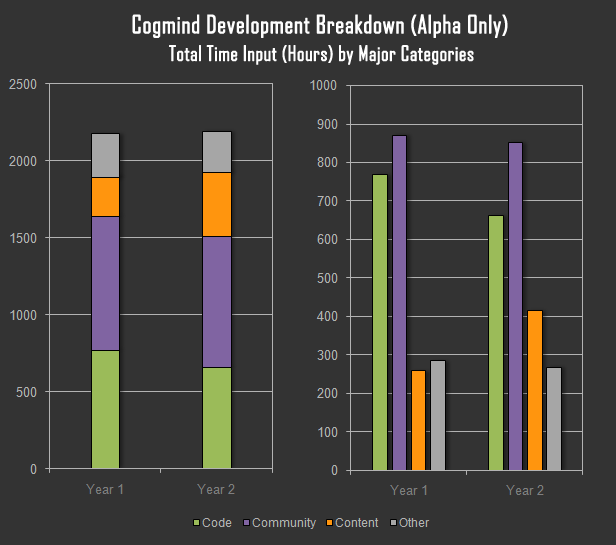
The breakdown of the main categories of development time Cogmind Alpha.
Novice developers often wonder: "What percentage of time should be devoted to promoting a project?", So let's look at the breakdown of development time by main categories.
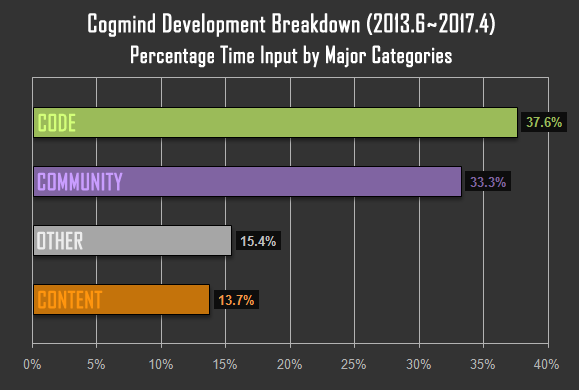
Cogmind , 2013 — 2017 ( 7DRL 2012 ).
66,7% 33,3% — /. , , roguelike , . : , - (, -, , ).
Cogmind . . ( .)
, 6% ( ). , , , . , .
Cogmind , , Steam.
- (. ), Steam . , , ! , , «» ( ). .
, , , Cogmind Steam. Grid Sage Games… , , .
Source: https://habr.com/ru/post/332748/
All Articles